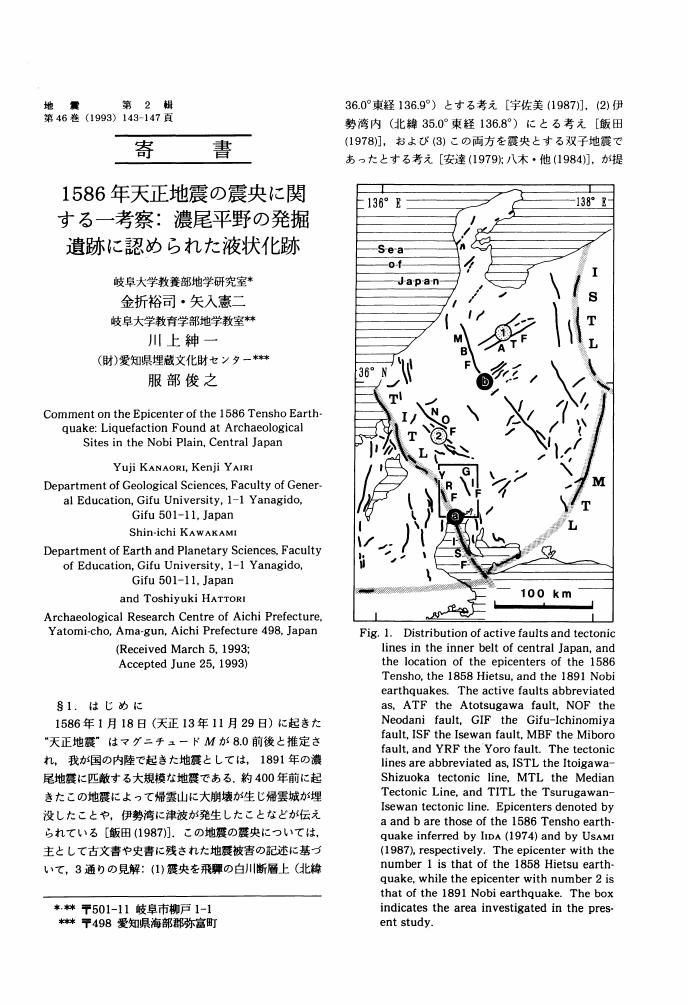9 0 0 0 OA 中部日本内陸に起きた被害地震(M≧6.4)の時空分布に認められる規則性
2 0 0 0 OA 1586年天正地震の震央に関する一考察
- 著者
- 金折 裕司 矢入 憲二 川上 紳一 服部 俊之
- 出版者
- 公益社団法人 日本地震学会
- 雑誌
- 地震 第2輯 (ISSN:00371114)
- 巻号頁・発行日
- vol.46, no.2, pp.143-147, 1993-09-24 (Released:2010-03-11)
- 参考文献数
- 27
- 著者
- 金折 裕司 川上 紳一 矢入 憲二
- 出版者
- Japanese Society for Active Fault Studies
- 雑誌
- 活断層研究 (ISSN:09181024)
- 巻号頁・発行日
- vol.1991, no.9, pp.26-40, 1991
- 著者
- 金折 裕司 川上 紳一 矢入 憲二
- 出版者
- 一般社団法人日本応用地質学会
- 雑誌
- 応用地質 (ISSN:02867737)
- 巻号頁・発行日
- vol.33, no.4, pp.187-201, 1992-10-10
- 被引用文献数
- 5 13
Dating back to 599 A.D., 26 destructive earthquakes of magnitude 6.4 or greater in the Kinki district of central Japan have been documented. A number of extensively developed active faults have been found in the Kinki district. Two major tectonic lines, the Hanaore-Kongo fault line (HKFL) and Tsurugawan-Isewan tectonic line (TITL) , can be identified as lines linking these active faults. The region north of the Median Tectonic Line, occupying the area between the two tectonic lines is defined as the intra-Kinki triangle (IKTA) , where N - S aligned mountain ranges are separated by basins, forming a basin/range province. Steeply dipping reverse faults separate the mountain ranges from the basins. Since it was found that the epicenters of most of the destructive earthquakes were located along the two major tectonic lines, these earthquakes were probably caused by the movement of active faults which constitute the tectonic lines. The average rate r^^-_e of the seismic moments released by the destructive earthquakes was compared with the average rate r^^-_s calculated from average slip rates of the active faults constituting the HKFL, TITL and IKTA. The average rates r^^-_s of the HKFL, TITL and IKTA were found to be in good agreement with the corresponding values of of r^^-_e The values of r^^-_s and r^^-_e for the HKFL and TITL. range from 0.015 to 0.030 x 10^26 dyne・cm/yr, and are significantly greater than those of the IKTA, that is, 0.001 to 0.004 x 10^26 dyne*cm/yr. These results imply that the seismic moments were mainly released along the tectonic lines. The examination of space-time distribution patterns of the destructive earthquakes clarified that active periods of seismic activity cyclically occurred on the HKFL and TITL. A scary earthquake of magnitude 7.5 or 7.4 was generated on the HKFL at the end of one such active period. When fault activity covers the entire length of a tectonic line, the active period ends. The HKFL and TITL are presently in the active periods, since three seismic gaps over which no destructive earthquakes have been detected during the present active period. One gap is on the TITL while the other two are located on the HKFL. Using the average rates r^^-_e of seismic moment release of the tectonic lines, dates of earthquake generation are tentatively predicted for seismic gaps.
1 0 0 0 OA 近畿地方に被害を与えた歴史地震 (M≧6.4) の時空分布に認められる規則性
- 著者
- 金折 裕司 川上 紳一 矢入 憲二
- 出版者
- 一般社団法人 日本応用地質学会
- 雑誌
- 応用地質 (ISSN:02867737)
- 巻号頁・発行日
- vol.33, no.4, pp.187-201, 1992-10-10 (Released:2010-02-23)
- 参考文献数
- 76
- 被引用文献数
- 9 13
Dating back to 599 A. D., 26 destructive earthquakes of magnitude 6.4 or greater in the Kinki district of central Japan have been documented. A number of extensively developed active faults have been found in the Kinki district. Two major tectonic lines, the Hanaore-Kongo fault line (HKFL) and Tsurugawan-Isewan tectonic line (TITL), can be identified as lines linking these active faults. The region north of the Median Tectonic Line, occupying the area between the two tectonic lines is defined as the intra-Kinki triangle (IKTA), where N-S aligned mountain ranges are separated by basins, forming a basin/range province. Steeply dipping reverse faults separate the mountain ranges from the basins. Since it was found that the epicenters of most of the destructive earthquakes were located along the two major tectonic lines, these earthquakes were probably caused by the movement of active faults which constitute the tectonic lines.The average rate re of the seismic moments released by the destructive earthquakes was compared with the average rate rs calculated from average slip rates of the active faults constituting the HKFL, TITL and IKTA. The average rates rs of the HKFL, TITL and IKTA were found to be in good agreement with the corresponding values of of re. The values of rs and re for the HKFL and TITL range from 0.015 to 0.030×1026 dyne-cm/yr, and are significantly greater than those of the IKTA, that is, 0.001 to 0.004×1026 dyne-cm/yr. These results imply that the seismic moments were mainly released along the tectonic lines.The examination of space-time distribution patterns of the destructive earthquakes clarified that active periods of seismic activity cyclically occurred on the HKFL and TITL. A scary earthquake of magnitude 7.5 or 7.4 was generated on the HKFL at the end of one such active period. When fault activity covers the entire length of a tectonic line, the active period ends. The HKFL and TITL are presently in the active periods, since three seismic gaps over which no destructive earthquakes have been detected during the present active period. One gap is on the TITL while the other two are located on the HKFL. Using the average rates re of seismic moment release of the tectonic lines, dates of earthquake generation are tentatively predicted for seismic gaps.
- 著者
- 矢入 憲二
- 出版者
- 日本地質学会
- 雑誌
- 地質學雜誌 (ISSN:00167630)
- 巻号頁・発行日
- vol.103, no.9, 1997-09-15




